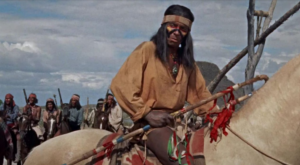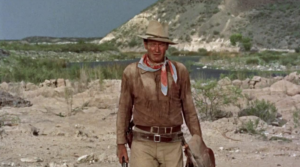3 Hondo (1953)
Race and Gender in Hondo
By Larissa Williams
Acclaimed actor Robert Duvall once said, “It’s a cyclical thing. When they make one, everyone loves them. Different genres come around in succession. People always welcome the western. It’s America’s genre.” When considering the Western genre, it makes sense why, above all the other genres out there, Duvall’s words are true. In a singular way, the Western expresses values that have been considered markedly “American.” Values like individuality, self-reliance, strength, honor, and patriotism can all be found throughout these films, television series, and books. Moreover, the western can be seen as a celebration of what it means to be American as it embraces the struggle that comes with opportunity — at least for some. Whether loved or hated, this genre has embodied a sort of idealistic American identity and, as such, warrants notice.
When I think of the Western genre, John Wayne’s movies come to mind first. From his acting in Western and patriotic war movies, Wayne became an American icon and embodied personally much of the same values expressed in western films. As a result, I thought it only fitting to analyze one of his films in this genre. Hondo is considered to be one of the great, classic Western films and breaks out of certain stereotypes common for its time. The story follows an Army dispatch rider named Hondo Lane, played by John Wayne, who befriends a woman and her child (Angie and Johnny Lowe) living alone in Apache territory. The circumstances are tense as there has been conflict between the army and the Apache tribe, putting the settlers in danger. Hondo and the Lowes are kept safe by a friendship between themselves and an Apache chief Vittorio until the chief is killed and is replaced by a more bloodthirsty chief Silva. As a result, the settlers are evacuated by the army and have to fight off an attack from the Apache. There are a few different representations that could be analyzed in this film, including how gender norms/values and Native Americans were depicted.
Hondo appears as one western who represented the Native Americans in a more kindly and fair light. One way this was accomplished was by having the titular character Hondo Lane be of mixed heritage: both Native American and Euro-American. In addition to having Native American heritage, Hondo had lived with the Apache and once had an Apache wife. This was not depicted as being an inferior or a negative thing. The romantic relationship that develops between Hondo and the female lead Angie Lowe shows some level of approval for a relationship between a white woman and a man with some Native American blood. Furthermore, the Apache chief Vittorio was depicted as noble and fatherly and shown to value courage and honesty. According to professor Kenneth Hall, Hondo is, “a pro-Indian narrative in which the only evil characters are those, mostly whites but in one case an Apache, who will not bridge the racial gap. Hondo’s mixed status allows him to work in both fields” (Hall). While there is one particular Apache antagonist, they aren’t regarded negatively overall. This pro-Indian view is reinforced by Hondo’s comment when told that a certain General Crook would be arriving soon and that it would assuredly be the end of the Apache. To this news, Hondo says, “Yeah. End of a way of life. Too bad, it’s a good way.” This shows a level of regard for the Native American people and lifestyle.
This is not to say that Hondo stands without flaw in respect to Native American representation, however. Michael Marsden, a professor and co-founder of the Journal of Popular Film and Television, points out that in the screenplay for Hondo, the writer Grant could show the Native American culture in a less than respectful way. For example, “Grant refers to the dialogue of the Apache Silva as ‘glub, glub, glub’” (Marsden). Connected to the topic of language, the Native Americans in Hondo (as in many other westerns) were presented as having poor English speaking skills. It is pointed out in The Oxford Handbook of Language and Race that this film representation supports a view of Indians as being less intelligent and brutish (Alim, pg. 372). Another negative point in regards to the Apache representation is that of the actors playing them. Instead of employing Apache or any Native American actors for the main Apache roles, a caucasian played the chief Vittorio and a Mexican played the chief Silva.

The treatment of Native American representation in this film seems reflective of John Wayne’s own views about them. While he didn’t hold outright negative views against Native Americans, Wayne did support the Western expansion as it was “a matter of survival” for the settlers and the tribes had been “selfishly trying to keep it [the land] for themselves” (Mikkelson). As shown, one can see more discrimination behind the scenes than in the primary message of the film.
As the Western genre represents an ideal of American identity, the main character of this genre has represented an ideal of American masculinity. Benshoff and Griffin, authors of America on Film: Representing Race, Class, Gender, and Sexuality at the Movies, describe this point, “the Western promotes a masculine ideal of a strong, unemotional, aggressive hero closely tied to nature and hard manual labor.” These authors later go on to say that John Wayne’s, “cowboy image is still considered by many to be the epitome of American masculinity” (Benshoff and Griffin). The character of Hondo falls into this category. Hondo is not without tender emotion, however. This can be seen in the way that he treats Angie and speaks of his former wife — the latter done in a poetic way that shows some sensitivity.
Overall though, Hondo exhibits all the values of American masculinity, something that John Wayne personally esteemed. In the opening shots to the film, the camera shows Hondo striding towards the ranch on foot and carrying a rifle. The camera pans to the Lowe’s reaction to him coming and back and forth between them until Hondo reaches the ranch. This filming (shown originally in 3-D) presents Hondo in a distinctly masculine light.

He strides forward in the middle of the screen under the bright outdoor lighting – a figure of independence and strength. Hondo is shown to deeply value honesty, which impels him to refuse to lie for chief Vittorio (fortunately so) and to reveal the truth about Angie’s husband’s shameful ways and that he killed him. He is also shown to be brave in the film. At one point, Hondo is captured by the Apache. The viewer is given an establishing shot of the congregated Apache warriors and Silva with more warriors riding in, accompanied by harsh jarring music. The camera follows and focuses on Silva until he reaches Hondo, which built the intensity and danger in the scene. Hondo is bound and sitting on the ground and the camera points upward when he speaks to Silva. This type of upward filming can be implemented simply because of a natural height difference, it also imparts a sense of a difference in power. In this scene, Silva is seemingly in control as it is well within his power to kill Hondo. Therefore, Hondo’s subsequent defiance of him by the use of insults makes his bravery that much more prominent. Another masculine ideal that he exemplifies is becoming a protector for Angie Lowe and her son. In this movie, it seems that the extreme ideals like self-sufficiency and remaining invulnerable were shown to be unsustainable, so in the end, perhaps Hondo finds a more healthy balance in depicting masculinity. In these things and more, John Wayne’s character captured much of the ideal for a straight, American male.
When choosing the film for this project, I first chose a John Wayne movie based as much on nostalgia as anything else. I grew up watching his films since I was young and they are both familiar and sweetened with memories. It is interesting to come back to childhood favorites and try to look at them objectively, seeing both their flaws and strengths. I appreciated how this film represented Native Americans in a more fair light and didn’t try to paint them in an extreme stereotype, either as an undeveloped enemy or a weak victim. John Wayne’s character was representative of the traditional masculine ideals, which was interesting to consider and analyze in determining to what extent these ideals are good and when they become too extreme. This western falls easily into the classic ideals of American identity. Although not without flaws, it does offer better representation than others of its time. There is still a struggle to see Native Americans depicted justly in films — not unduly glorifying or vilifying them, but representing them as complex human beings. I think this film at least tries to present them more along those lines – though it does have its weak points. How gender is represented in movies produced decades ago continues to be relevant. How John Wayne portrayed masculinity was (and I’m sure continues to be on some level) impactful on ideas of what men should be. Films, like other art forms, are powerful for the ideas in them, which can help shape cultures and perceptions. All that in mind, I would recommend this film. It is a fine example of a western with a level of depth not always shown in this genre. It is clear in all the values that this film supports in its characters how this western, like many others, continues the celebration of America’s identity. This film isn’t perfect, but then, neither is America.
REFERENCES
Alim, H. Samy, et al. The Oxford Handbook of Language and Race. Oxford, Oxford University Press, 2020.
Benshoff, Harry M., and Sean Griffin. America on Film : Representing Race, Class, Gender, and Sexuality at the Movies, John Wiley & Sons, Incorporated, 2009. ProQuest Ebook Central, https://ebookcentral.proquest.com/lib/linnbenton-ebooks/detail.action?docID=819377.
Hall, Kenneth Estes. (true). 2012. Apaches and Comanches on Screen. Studies in the Western. Vol.20 27-41. https://dc.etsu.edu/cgi/viewcontent.cgi?article=1594&context=etsu-works Accessed 28 February 2021.
Marsden, Michael T. “Louis L’Amour’s ‘Hondo’: From Literature to Film To Literature.” Literature/Film Quarterly, vol. 27, no. 1, 1999, pp. 16–20. JSTOR, www.jstor.org/stable/43797751. Accessed 28 Feb 2021.
Mikkelson, David. “Did John Wayne Say Native Americans “Selfishly” Tried to Keep Their Land?” Snopes, 2002. https://www.snopes.com/fact-check/john-wayne-native-americans/. Accessed 17 March 2021.

